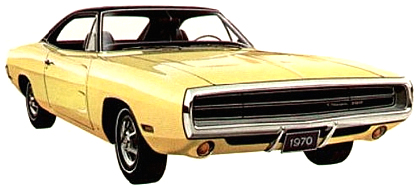The year 1970 was going to be THE YEAR in racing. It was going to be the year that Ford and Chrysler finally had their showdown. Chevy and Ford had been warring for years on the TransAm circuit, but now it was going to be Chrysler and Ford.
 And, the first time out, at Talledega, GA, the 1970 Charger Daytona set a new enclosed track speed record of 200 mph and they were waiting for Ford. But, Ford never showed and then Chrysler began to run into a series of tires snags because the tire technology of the time wasn’t ready for consistent 200 mph times.
And, the first time out, at Talledega, GA, the 1970 Charger Daytona set a new enclosed track speed record of 200 mph and they were waiting for Ford. But, Ford never showed and then Chrysler began to run into a series of tires snags because the tire technology of the time wasn’t ready for consistent 200 mph times.
Big-Winged Charger
So, the Charger Daytona, the Big-Winged, huge-downforce stock car went for a couple of months without its chief rival on the track and when they finally did meet, Ford won the tangle, even though the Charger Daytona was ready. According to various sources, the key problem was that neither Goodyear nor Firestone could develop an emulsion that would handle the tremendous downdraft forces generated by the huge two-foot wing that was designed for the Daytona by Creative Industries. It was a very special wing and though every dealer could take multiple orders – and some likely did – there were only actually about 500 Daytona’s delivered.
The changes to the Charger for 1970s were fairly minimal, although they did use a smaller front cross section that helped bring better drag numbers for aerodynamic efficiency and the engine for the Daytona was a choice of the 426-cubic-inch big-block that put 375 horses to the rear wheels through the 4.25:1 rear wheel. Another option for this vehicle – especially for the racing set – was the 425 horsepower 440-cubic-inch V-8.
With few changes to the body – the rounding was, if anything a big more subtle, and the roof was a bit more aerodynamic – the most notable changes were the more effective bright surround used up front and the dual bright surround used in the rear.
Recession Did Hurt
Maybe it was the recession of 1970 or maybe it was a case of being at the wrong place at the wrong time, but, the Charger’s sales plunge of more than 100 percent seemed to point to a problem with the industry. Like any other boom/bust cycle industry, autos faced their share of ups and downs and in 1970 a mild recession started a downward spiral not only for the Charger but also for other vehicles involved in the pony car wars of the 1960s.
It’s interesting to note that Charger sales were slow but steady at the time while Chevy and Ford did rebound a bit, but, on the whole, they never again approached the glory years of 1966 to 1969 when the muscle car segment was about as hot as one could find.
For the record, the Daytona still offered the four-speed manual and the three-speed automatic and it began to put some real character into its front bucket seating.
